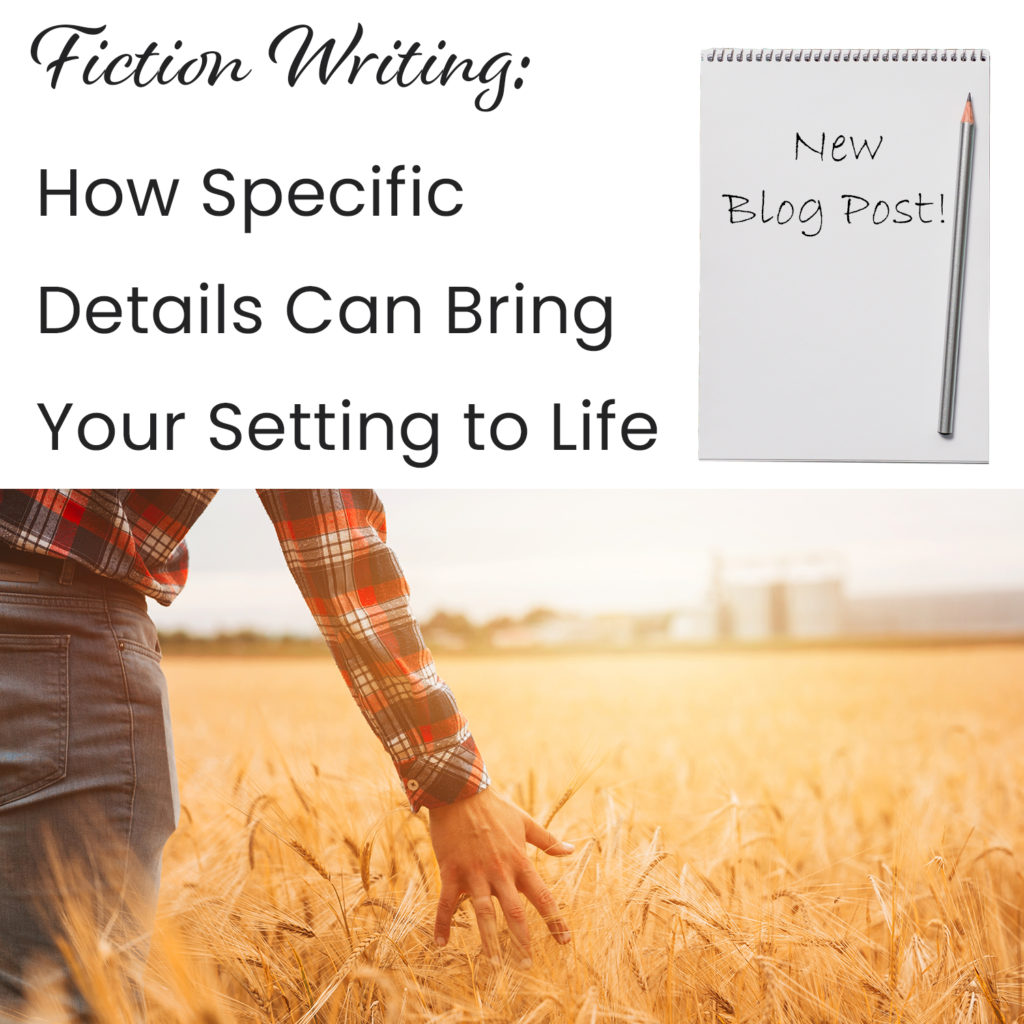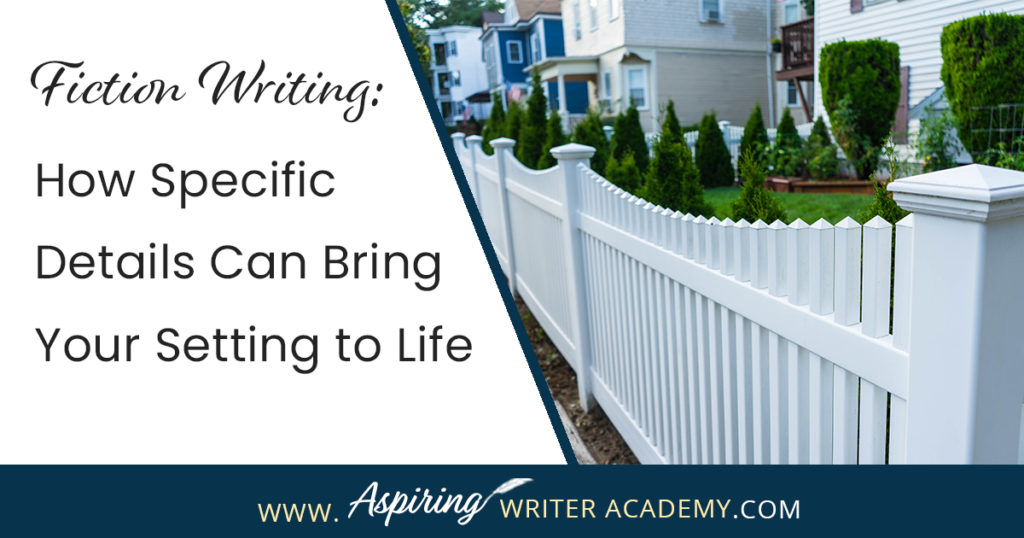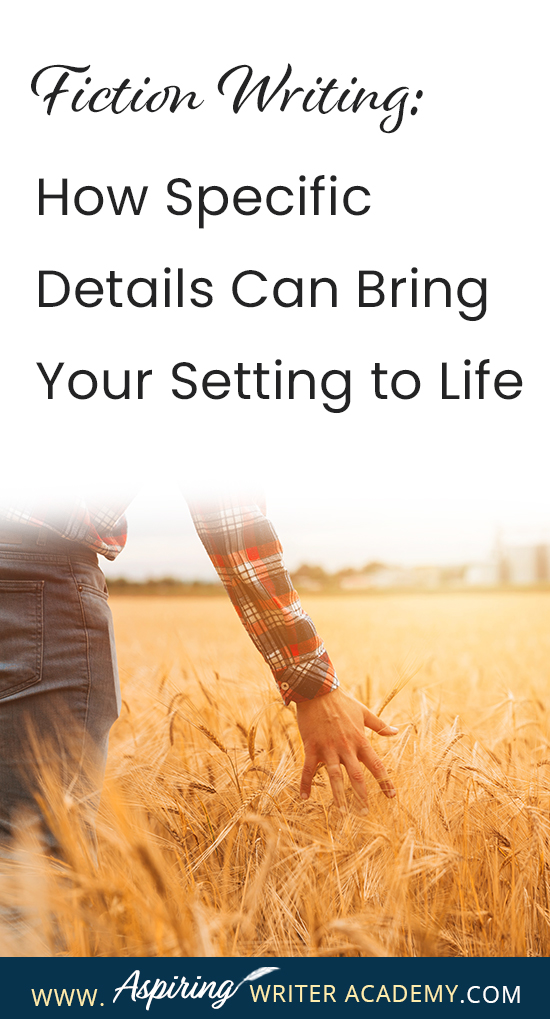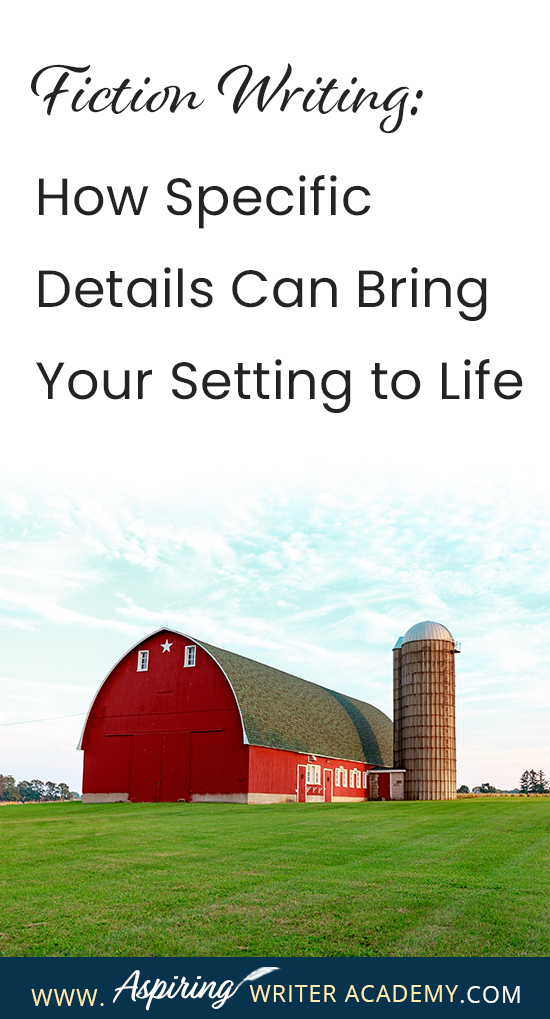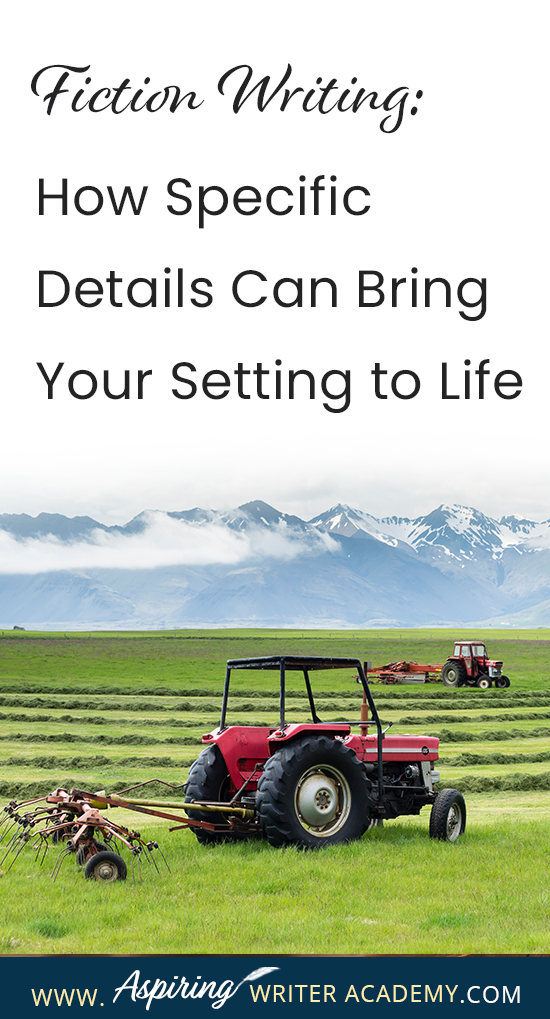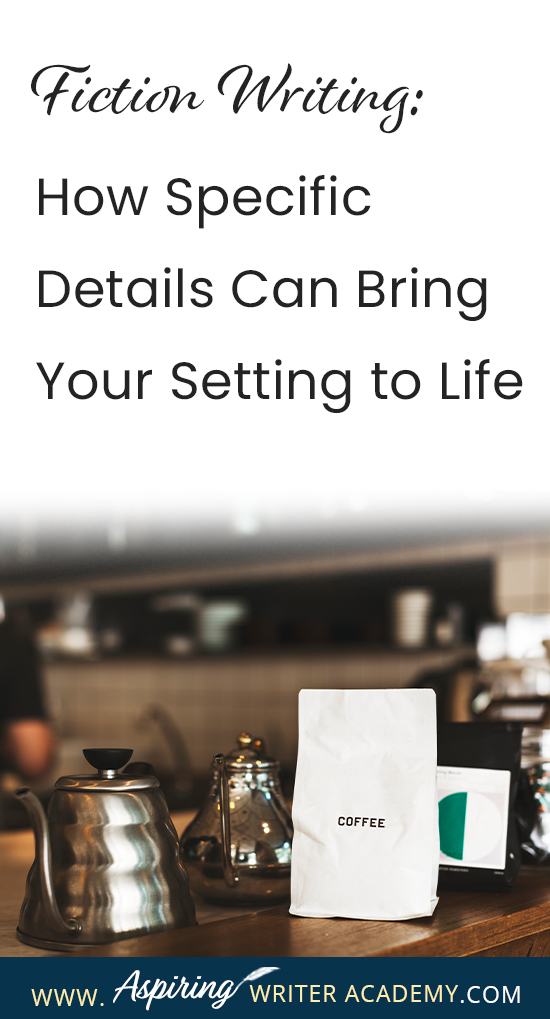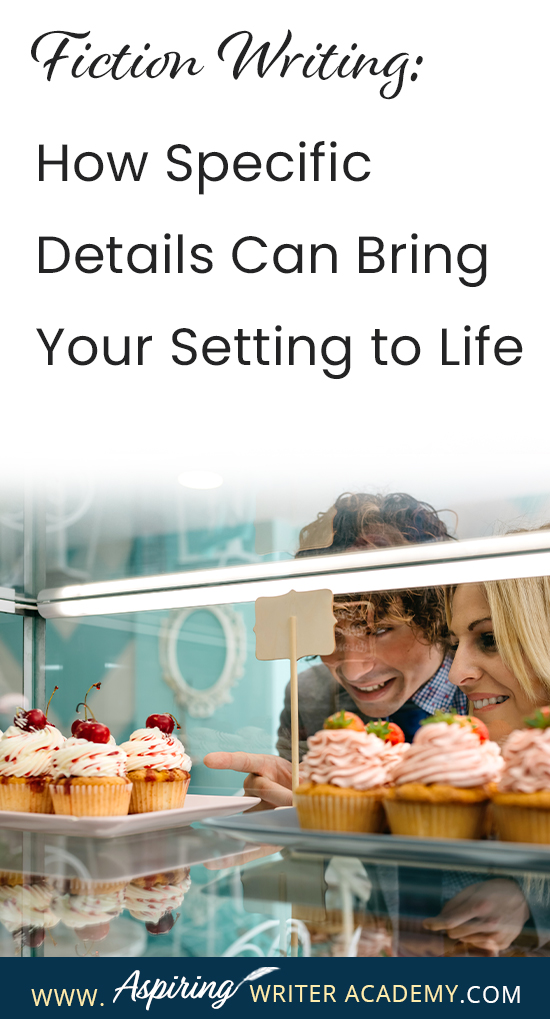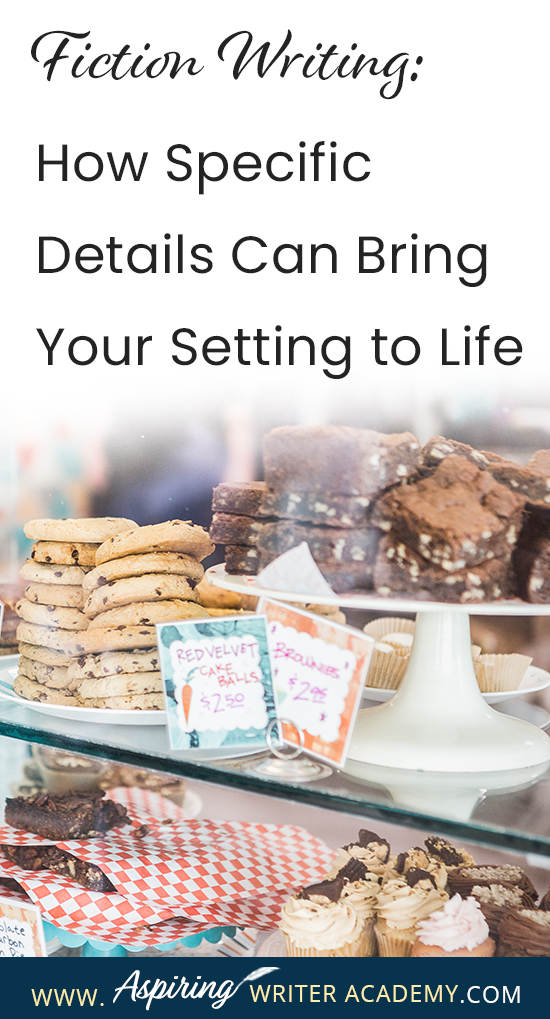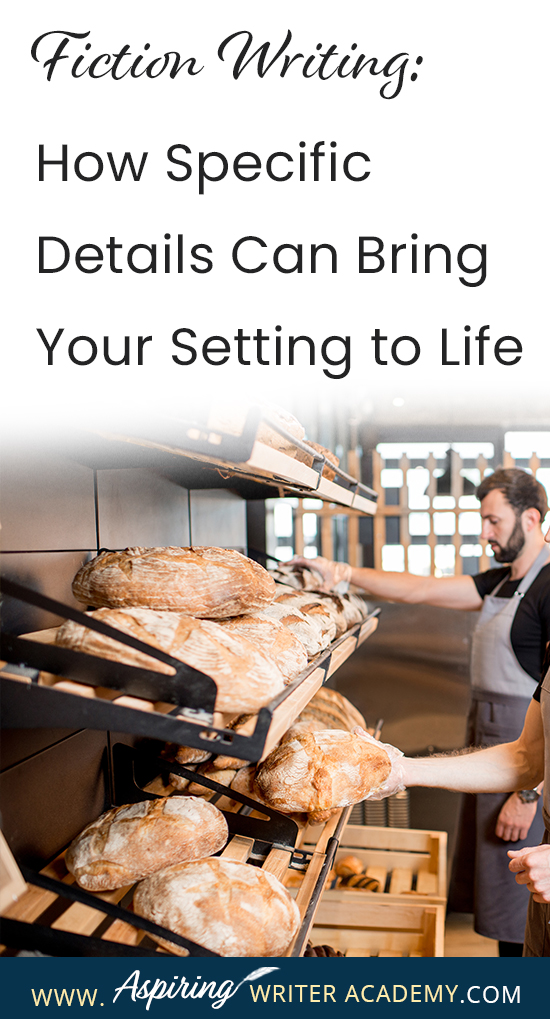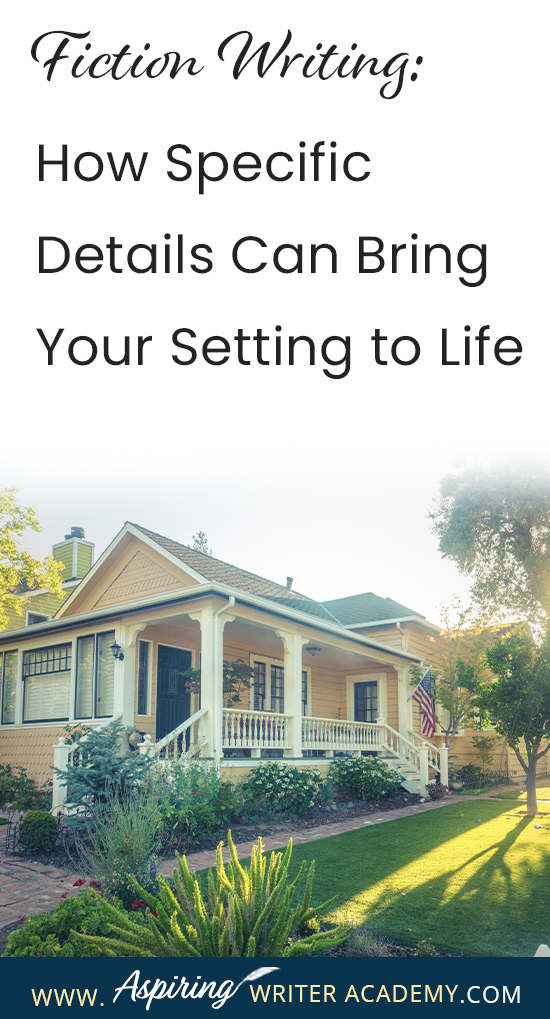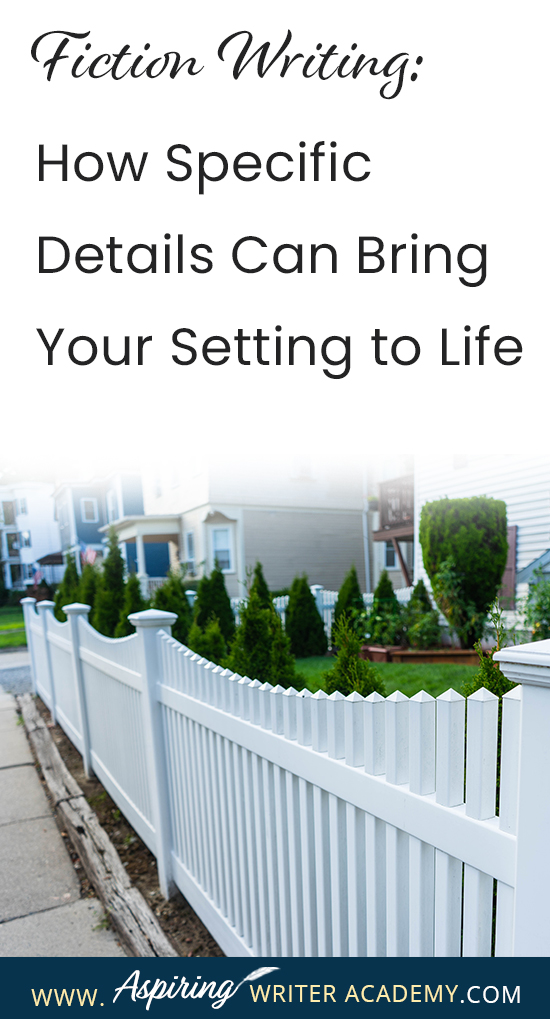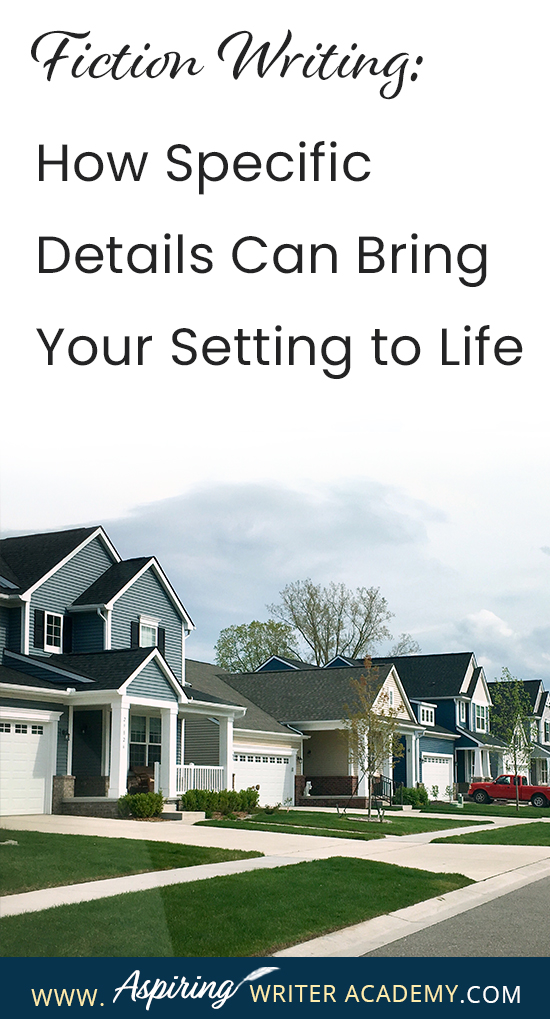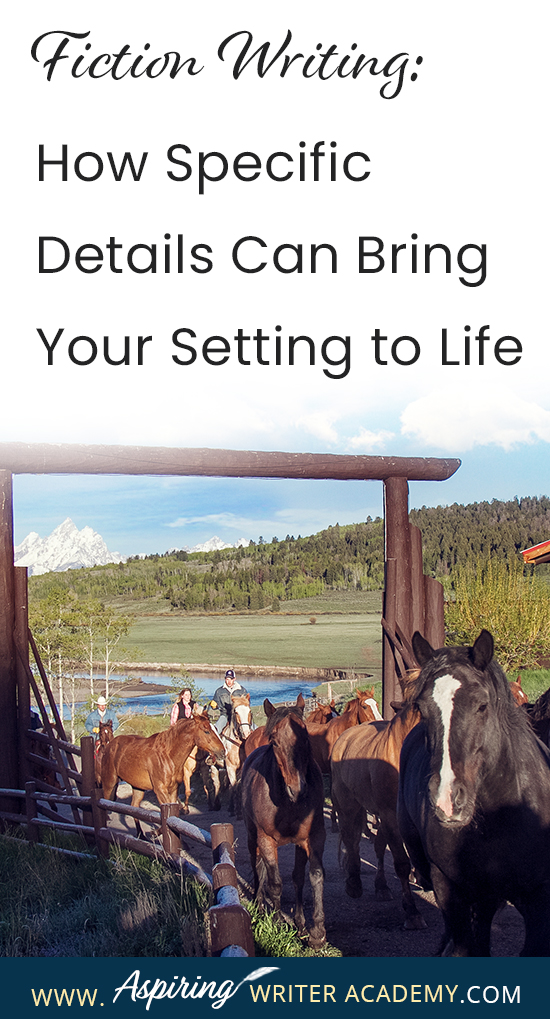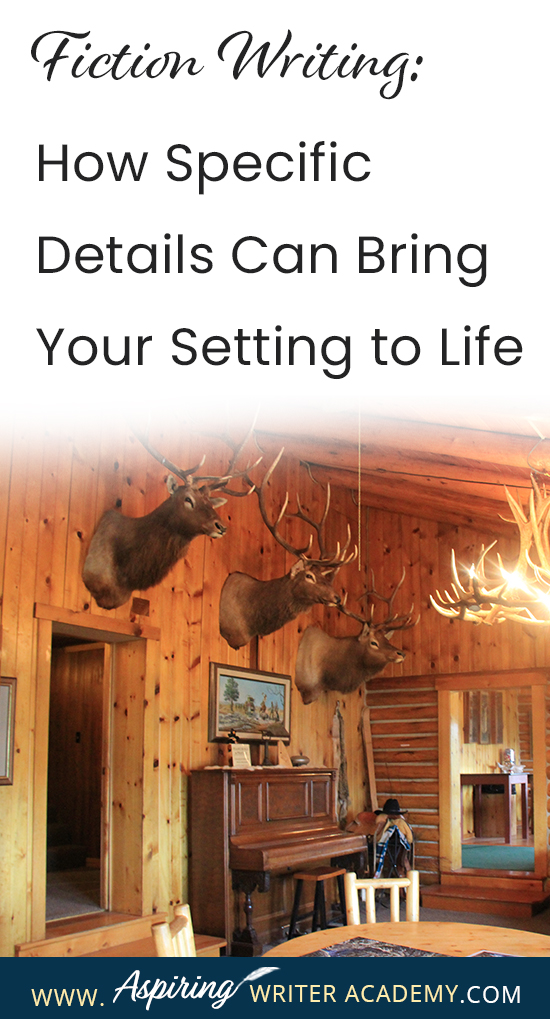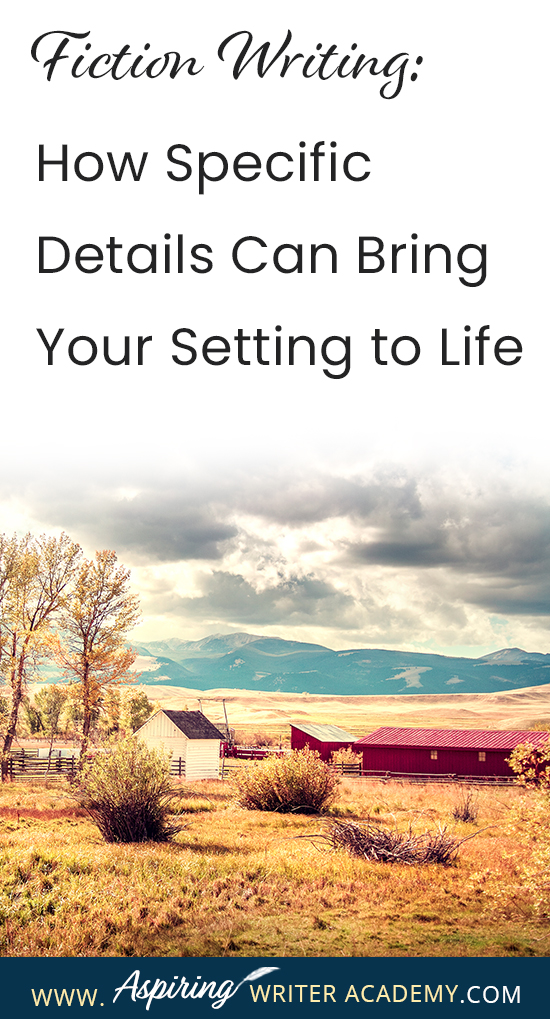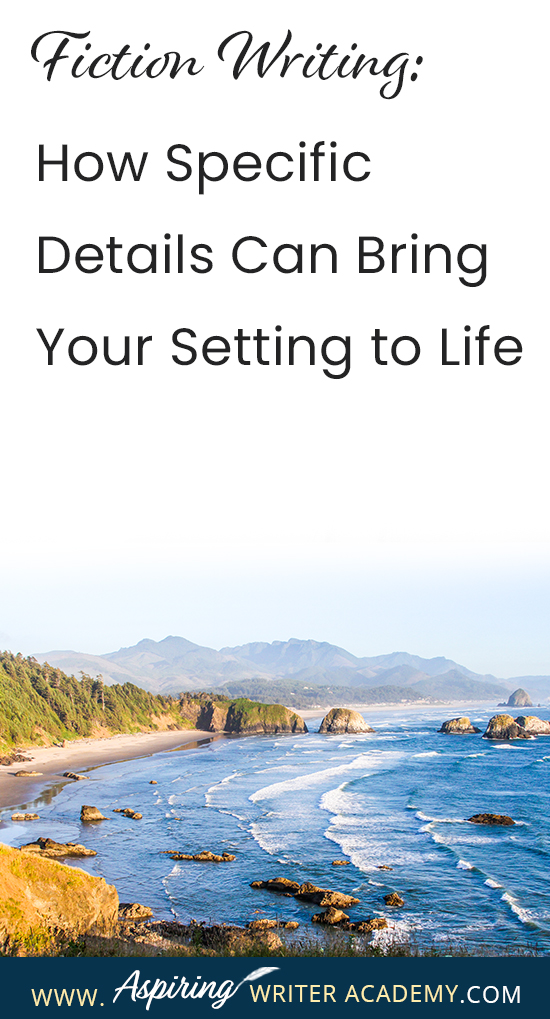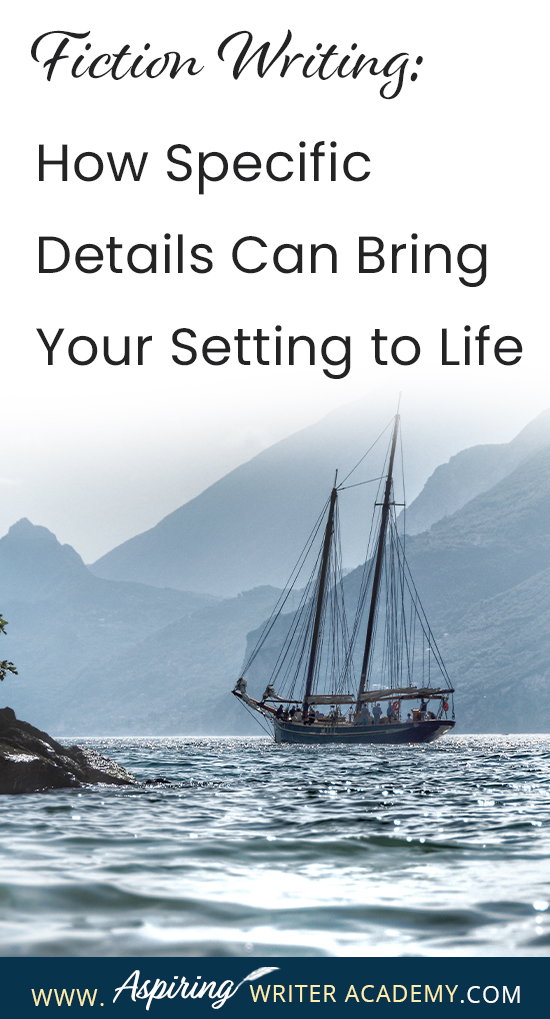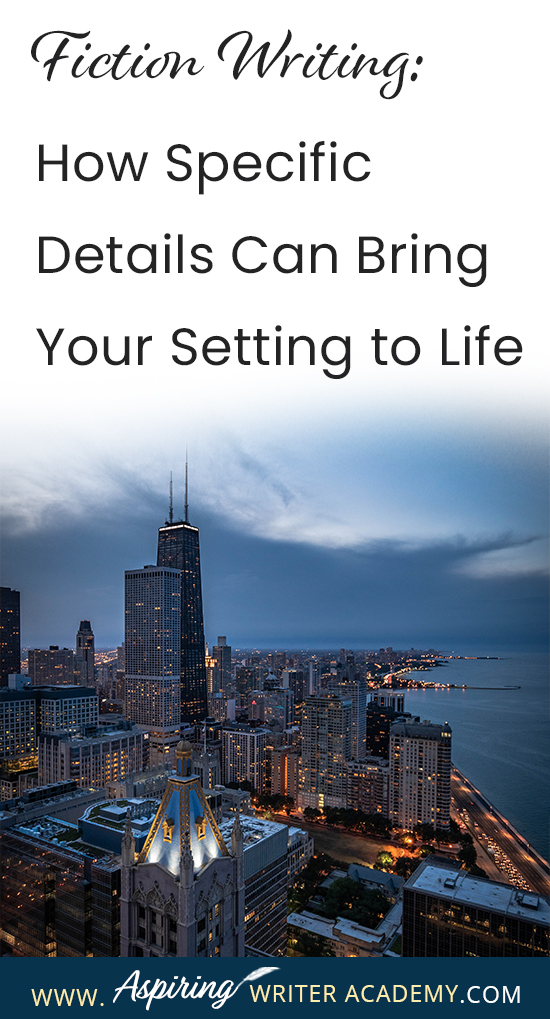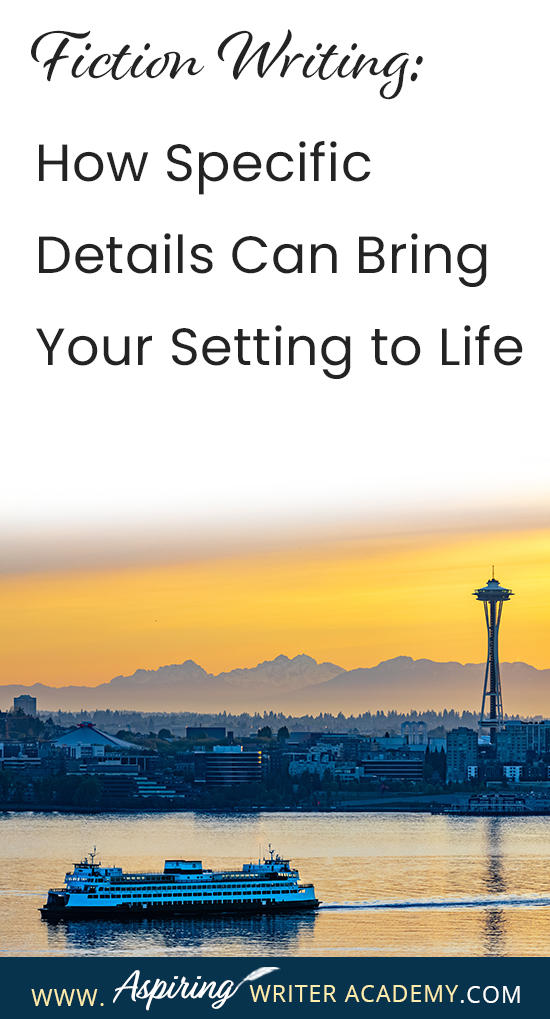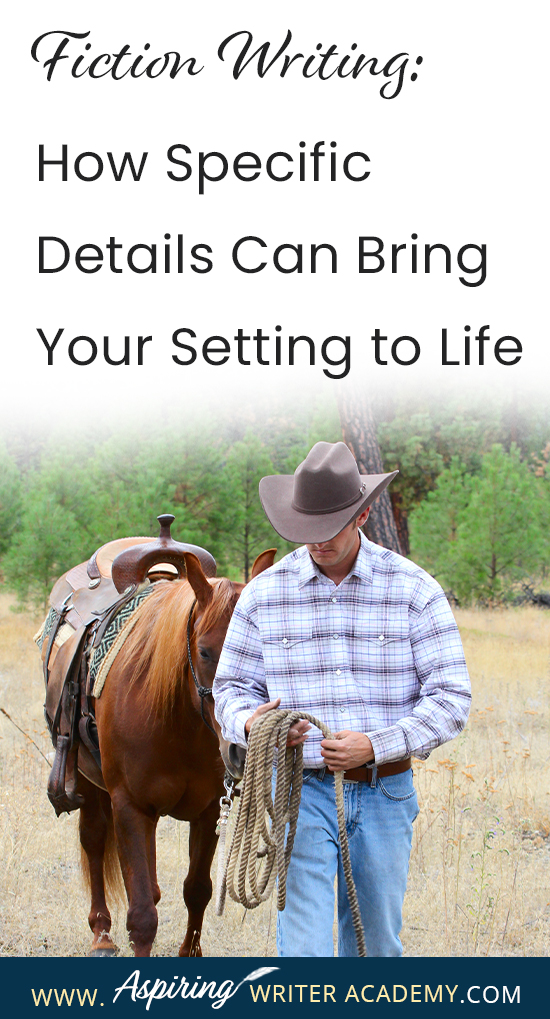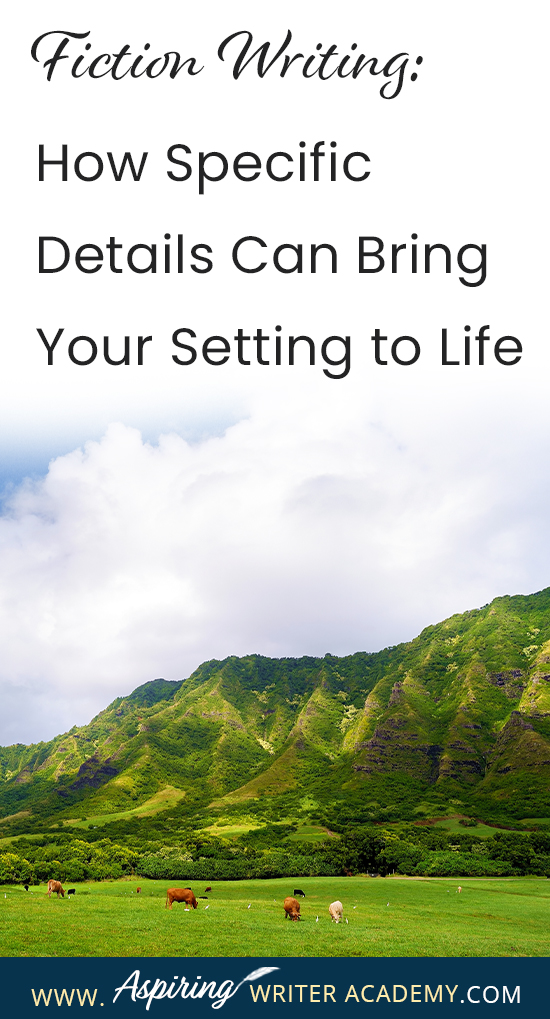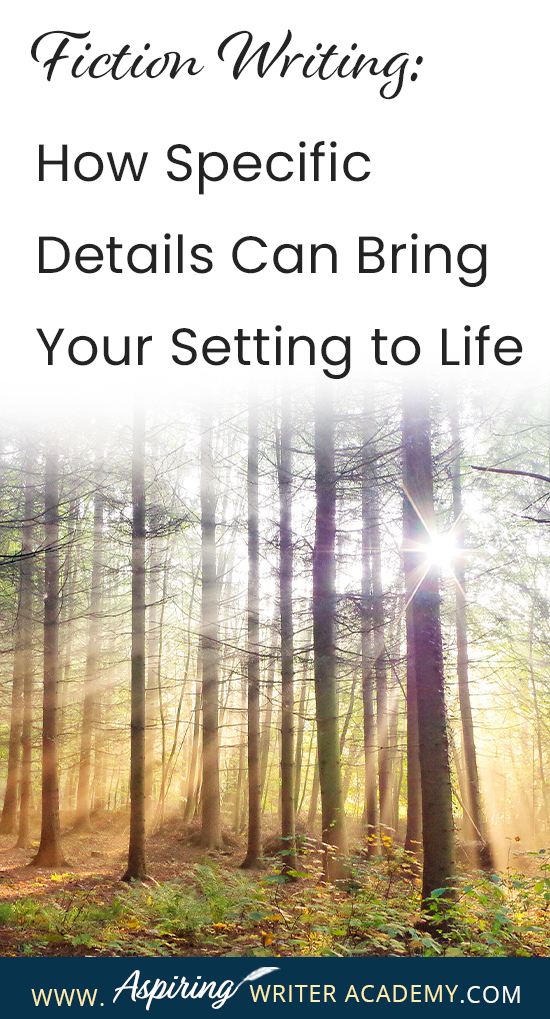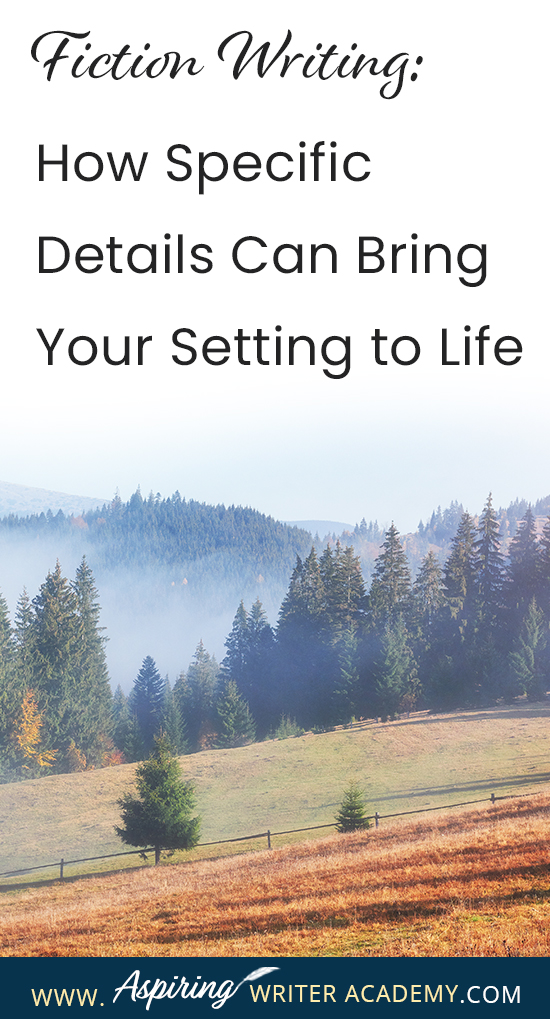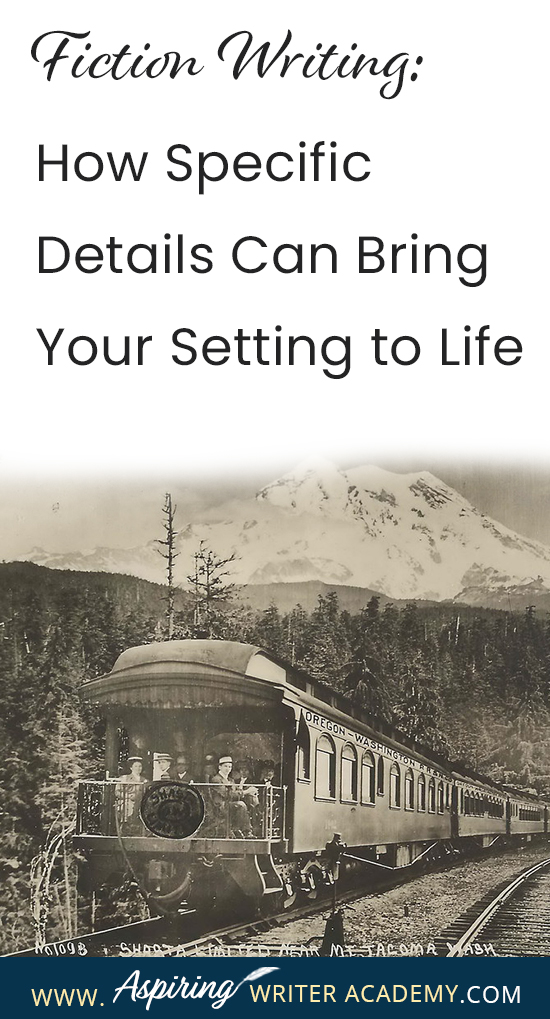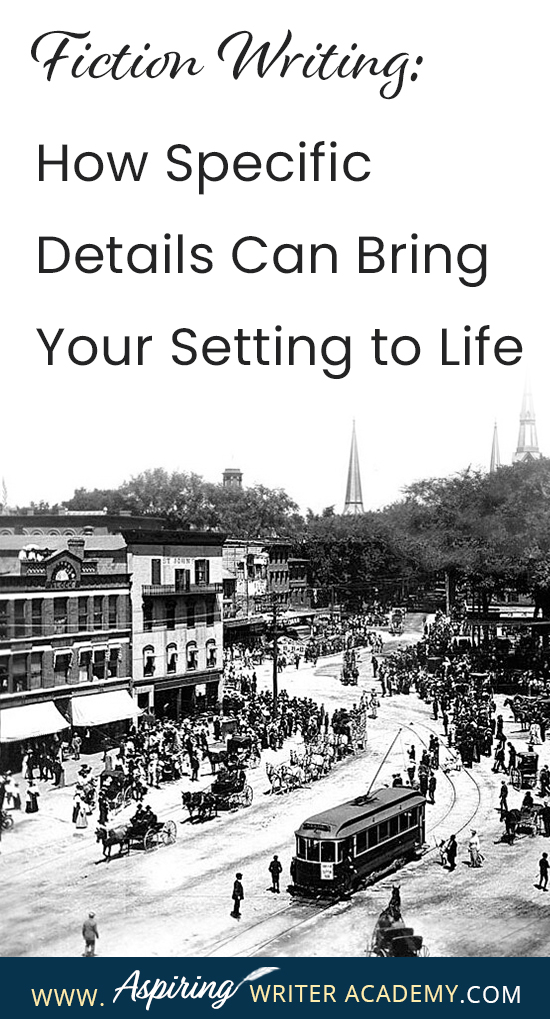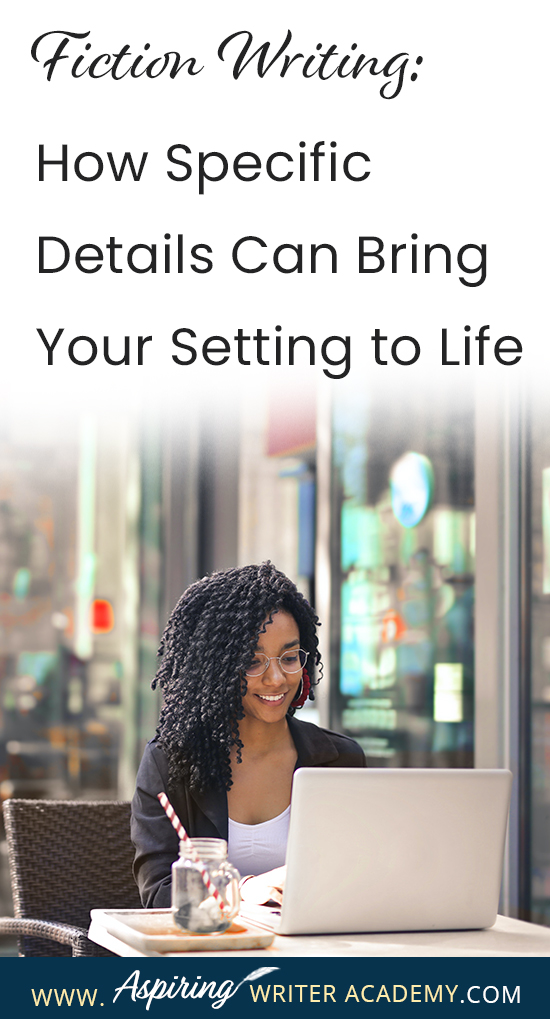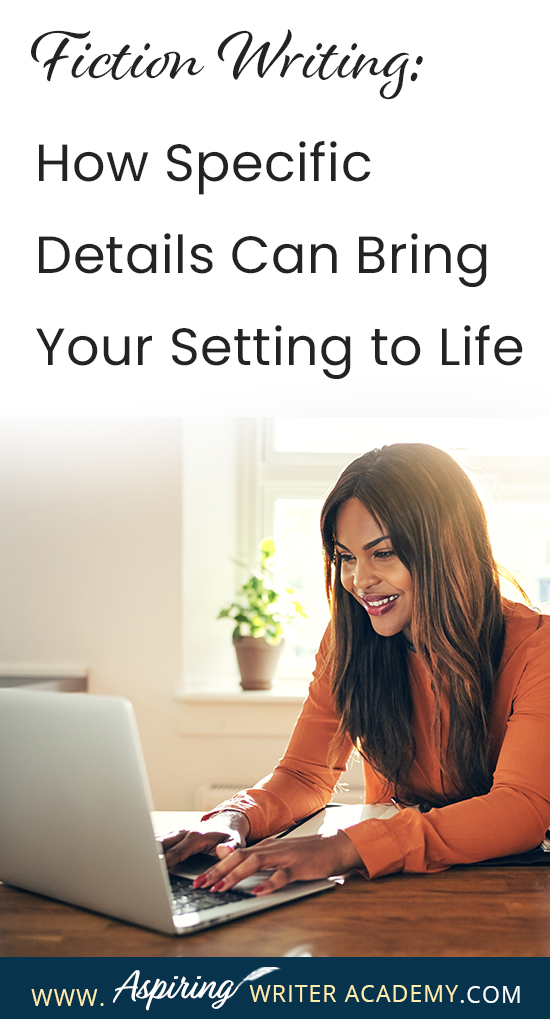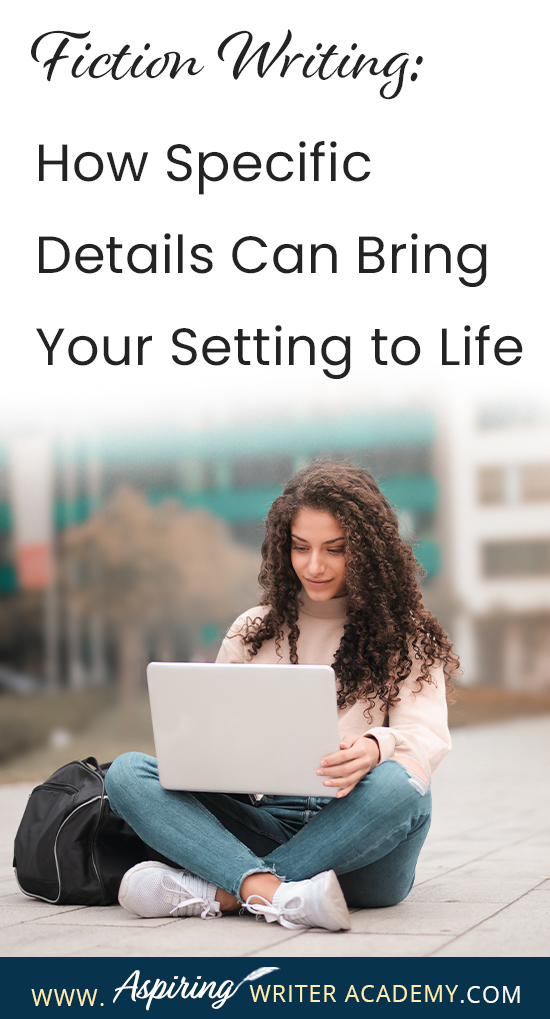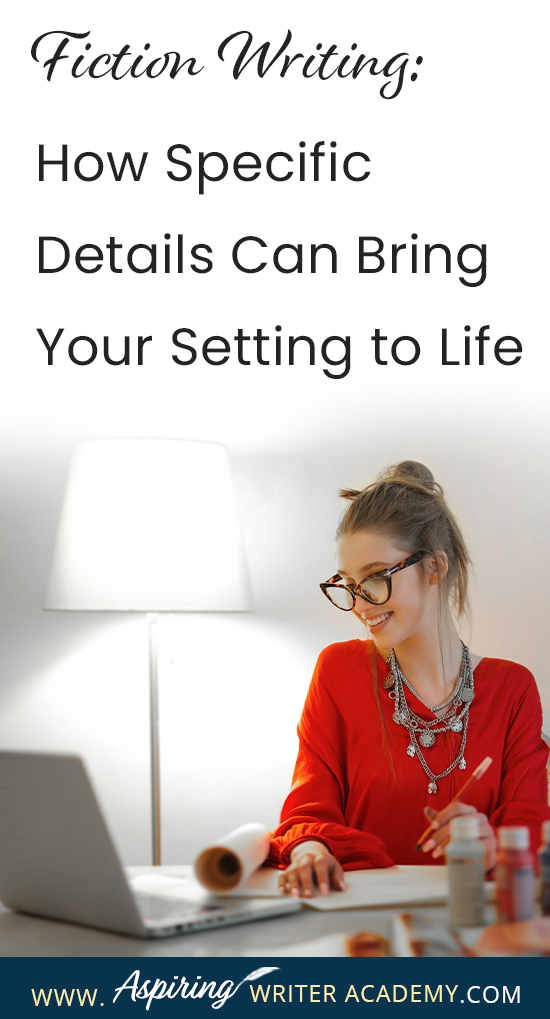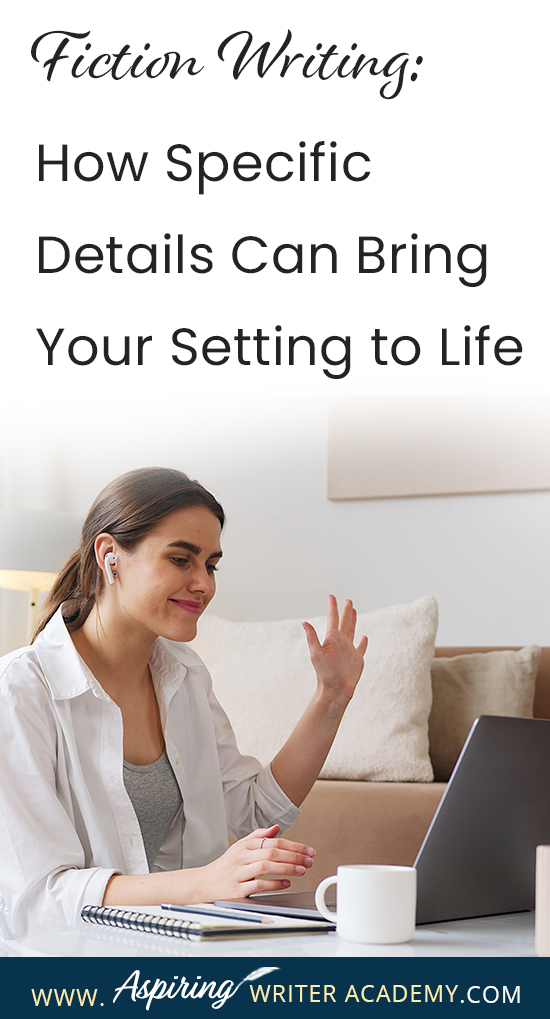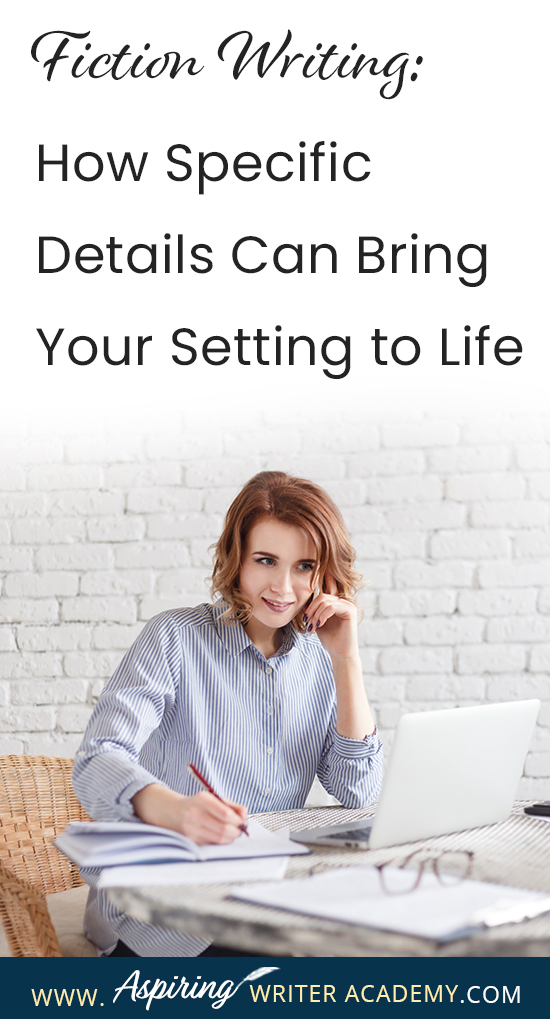Fiction Writing: How Specific Details Can Bring Your Setting to Life
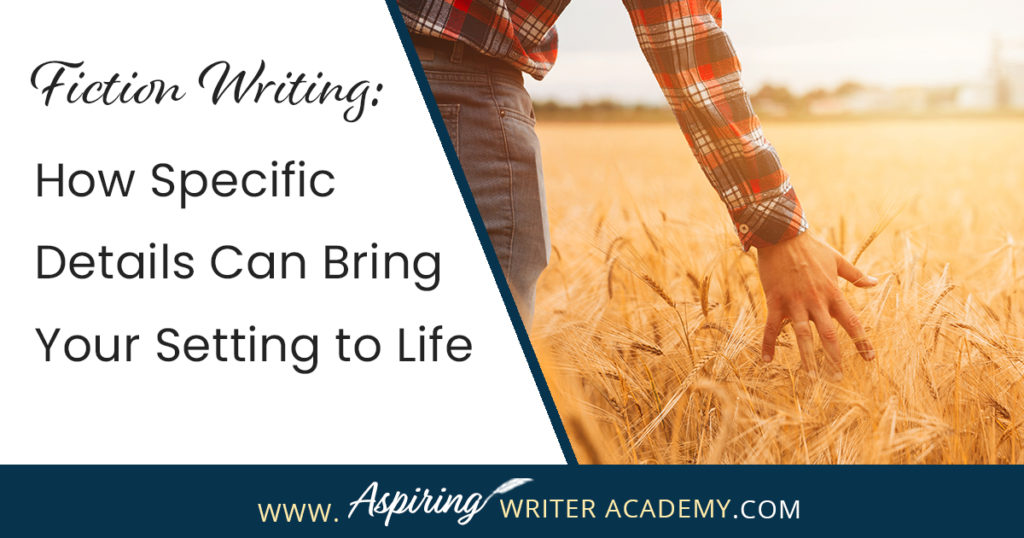
The setting for your fictional story can be so much more than just the general description of a place. The right details can depict mood, personality, theme, character change, and touch the reader’s emotions in profound ways.
In our post, Fiction Writing: How Specific Details Can Bring Your Setting to Life, we discuss several techniques to help you craft meaningful scenes that will deepen your fiction and entice readers to rave about your story world as if it were a real place.
In the post below we will discuss:
- Various setting elements
- “Stage set-up” and scene props
- Symbolic objects
- Using the 5 senses
- Personality identifiers
- How settings can change with perspective
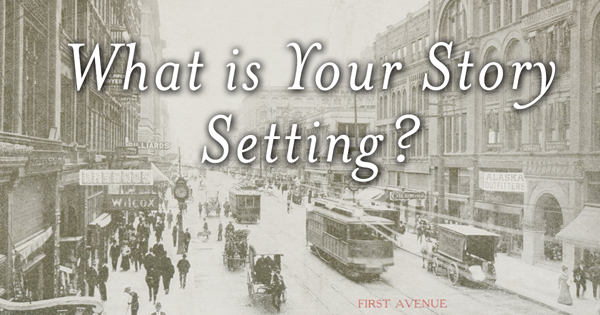
What is Your Story Setting?
If you are writing historical fiction, perhaps the cover image itself will show the story setting. A book cover with people dressed in Victorian attire in front of old buildings and horse-drawn carriages may give away your story setting in an instant.
The second clue for the reader would be on the first page, under the Chapter 1 heading, where most historical novels will begin at the left margin with the year and place the story is set in italics.
Example:
September 1895, New York City
Washington Territory, 1853

The cover may also reveal the setting if you are writing other genres such as fantasy, science fiction, or a contemporary set on a ranch. If it is significant for the reader to know the exact time period and location immediately, before the first line, the novel may start with time and place.
Examples for other genres:
Year 2093, in a Galaxy Far Away, Planet E-6
Autumn, in the Shire, upon Middle Earth
Chief Joseph Ranch ̴ Darby, Montana
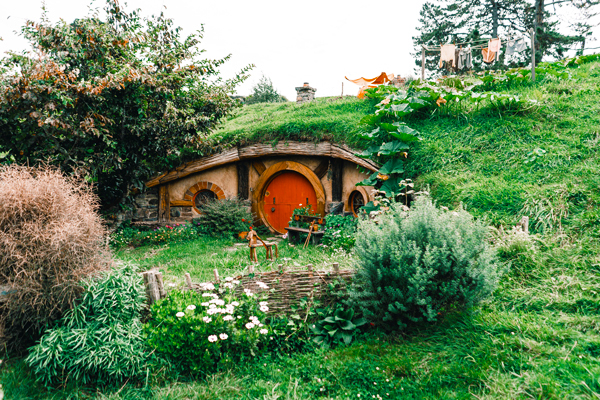
This technique can also be used for contemporary stories where the setting frequently switches back and forth, like when the story has two or more groups of people at different locations. By naming the date and location upfront, the reader does not become confused between transitions.
However, many novels do not use an italicized heading, and instead reveal the setting through various details within the first few paragraphs of the story.
It is important to “ground” the reader, give them some setting details to allow them to picture where the scene is taking place before the action begins and the characters start talking.
This is especially true when switching (POV) point of view and scene locations.
Whose POV starts this scene?
Where are they at?
Can you incorporate some of the other setting details listed below into the opening lines of each scene before the characters get into the real action?
Time: (morning, afternoon, evening? Dawn? 9 am? Noon? 5 pm? Midnight?)
Place: (inside, outside, at school, at home, in a bedroom or kitchen, on earth or the moon?)
Season: (Winter, Spring, Summer, Fall?) or (Life seasons: of youth, young adult, middle age, or perhaps senior living?)
Day/Month: (Which day of the week or what month?)
Weather: (sunny, cloudy, misty, muggy, stormy, rainy, snowy)
Temperature: (hot, cold, 70 degrees, mild, sweaty, scorching, freezing)
- Special Note: It is important to remember that you shouldn’t bog down the opening of each scene with paragraphs of static description. Ideally, you will want to ‘sprinkle’ these details in as the scene progresses. Start with a few key descriptors, perhaps in a line of two at the beginning of the scene, then thread the other details in between the dialogue and action.
Mood:
Is the character in a foul, bitter mood, or a happy mood? Do any of the setting elements have anything to do with the character’s mood? Or is the character’s mood caused by something else? (Perhaps another character or event?) Why is the character in this mood?
How can the above elements reflect the character’s mood? If the character is not happy, perhaps he sees the world as gray and dismal with cloudy skies and unrelenting rain.
How can the character’s mood contrast with the outside elements? If your character is not happy, and the world is bright, colorful, and sunny, he may resent the fact the world isn’t reflecting how he feels. The character may be angry at the sunshine or another character who is in a good mood because of the sunshine. Perhaps the songbirds are sweetly chirping, but this character is just not a morning person. To some, moonlight may be romantic, while others may think moonlight is dangerous or distant and cold. Cornered in a sticky situation, perhaps your character is sweating even though the temperature outside is below freezing.

What is the “Stage Set-up?” and How are Props used in this Scene?
Imagine the scene you are about to write as a play. What would the audience see when the curtains lift? What would be on stage?
What are the colors in this scene?
Which items are colorful or stand out from all the others?
What kind of lighting?
(Is it bright, gray, sunset orange? Are there shadows?)
Remember that if the lighting is dark so that it is hard for the character to see, then the character will not be able to describe items or faces of other people in the scene with explicit detail. Everything would be dim and fuzzy.
What ‘props’ does your character need for this scene?
Which objects will the character interact with?
Which items are important for the character to achieve their scene goal?
Exercise: Before you write the scene, make a list of all the objects that would be in the room or in a place like this.
- What are the special objects? The items the character will first notice. Which details about this object attract their attention and why? Does this object hold special meaning? Is it tied to something in the character’s past? Does the item remind them of something they detest or enjoy? Does the object or item have anything to do with their mission or the external circumstances of the plot?
Example:
When a character who is a neat-freak walks into someone else’s house, the first thing she may notice is a sink full of dirty dishes, cobwebs hanging from each corner of the ceiling, the layer of dust on the coffee table, and the frayed curtains.
Another character may ignore the dust and walk straight toward the porcelain figurine of a dancing couple on the fireplace mantle because it reminds her of her grandparents and the love that she herself would like to find.
Another character may walk into the room and immediately scout out all the exits, and spot the shotgun standing in the corner of the room, along with the wrought-iron poker by the fireplace, which could also be used as a weapon if necessary.
Which props should be in this scene to either help or hinder the main characters?
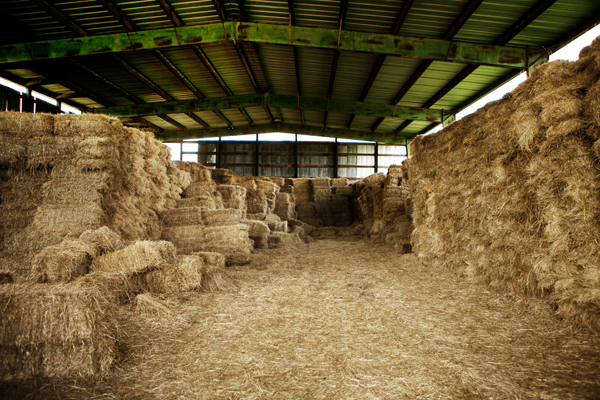
Example:
The heroine may need to hide from the villain in a barn, but if the barn if filled with hay and the heroine is allergic to hay and starts sneezing, then this could place her in danger and allow the villain to find her location.
Or perhaps you have two characters in a fight scene, and they need weapons to defeat one another in the battle. What kind of objects are around them, in that natural setting, that they could pick up that might give one an advantage over the other?
Or suppose you are writing a mystery, and one of the clues is hiding in the room in plain sight. Did you set this up by describing everything that the character first saw upon entering the room? Which object did the detective overlook upon his first inspection? What led him to discover the object his second time around? Which details?
It is best to foreshadow that an object will be needed later in the story by describing the item through the eyes of the character as they enter the room. Or have the character interact with the item before it is a help or a hinder to achieving their scene goal. (In other words, set it up before it is needed so it does not seem contrived when the big moment comes.)
Symbols and images which represent your theme and reflect your message should be embedded into your story whenever possible. This could be an object that holds special meaning that keeps showing up again and again.
Example:
If the character believes that butterflies are a symbol of hope (because of an encounter from their past) and the message of the story is to ‘keep the faith, do not lose hope,’ then perhaps this character keeps seeing butterflies turn up in the story in the most unusual places to encourage her to go on, to persevere, and continue to achieve her story-worthy goal. Perhaps, just as the character is about to give up, she sees a butterfly, and that gives her the strength she needs to pick herself up and attempt to solve her problems one last time!

Are there any items that symbolize what the character hopes to achieve?
Example:
The character may hold tight to the treasure map with an X designating the location of the buried treasure. The character may take extra care to safeguard this map and keep it away from others. His goal is to find the buried treasure before anyone else. (This item could be used as a source of conflict within a scene.)
Or perhaps there is a certain item the character treasures beyond all other things and his obsession with the item hinders his ability to live a full life. What the character may need to learn is how to let go of this item, and that other things, perhaps a relationship, is more important.
This item should appear several times throughout the story and cause the character conflict. Then if the character lets go of the item at the end, the reader sees his character change, growth, and the release of this tangible item shows this change. Better to show the character change at the end of a book with a concrete item, than to just ‘tell’ the reader he is changed or intends to change. If he lets go of the item, he proves he is changed.
In a romance, if a character cannot commit to marriage at the beginning of the novel and then in the last chapter, he pulls out his grandmother’s heirloom ring and proposes to the one he’s come to love, the reader knows for sure he is changed. (Of course, the events of the novel would have to instigate and support this character change to be believable.)

How Many of the 5 Senses Can You Use in this Scene?
What does your character see? What can he hear? What can he smell, taste, or touch?
Can the character feel the warm sunshine upon his skin or the cool breeze whip through his hair? Is the skirt she is wearing made of scratchy material that makes her itch? Are his calloused hands rough when he touches her? Is the couch hard or soft? What is the texture of the character’s hair or of the outside tree bark, or the interior furniture?
Does the teapot emit a shrill whistle? Are his bellowing shouts loud enough to deafen her ears? Is the tomato and garlic beef stew a savory dish? Or as distastefully pungent as a pigpen?
Exercise: List the 5 Senses that could be included in each scene:
See/sight: (images, colors, lighting):
Hear: (sounds):
Smell: (scents, aromas):
Taste: (sweet, bitter, sour):
Feel/touch (physical, or textures):
The strongest of the 5 senses to evoke memories and emotion is smell, followed by taste. If there are no items with taste or smell in the scene, what items in the scene can evoke memories with taste and smell?
Example:
His gaze fell upon the ill-won golf club trophy, and he recalled the last time he’d seen his long-time tournament rival. The memory pierced him with a bitterness that soured his entire being.
She picked up the old fashioned, ceramic plate and was overcome with fragrant memories of her grandmother’s mouth-watering apple pies. On baking days, the entire house had been filled with the luscious scents of apple, cinnamon, and nutmeg. Now, just the thought of that spiced aroma had her tongue salivating for at blessed taste and made her feel all warm and fuzzy inside.
Always try to include at least 3 of the 5 senses in every scene.
If you can include all 5 of the senses in one scene – that’s awesome! However, do not include them just for the sake of including them, or it will feel contrived.
Try to give purpose to the 5 senses in the scene. Why does this scent matter? Why does anything your character sees, hears, smells, tastes, or feels matter? How does it relate to the plot? What impact does it have on the character’s growth or character change? How does it help the character solve or overcome the story problem?

Which Descriptions Reveal Personality?
First, what are your characters wearing? How does their taste in style, color, and comfort reveal what is important to them? Does it reveal their profession? What in their past influenced the way this character chooses his wardrobe?
Before writing a scene, consider if what the characters are wearing has any influence upon the action or external plot.
Example: Does a loose belt on the woman’s coat get caught in the revolving door at the hotel?
Also consider, what impact their appearance may have either on themselves or the other characters in terms of motivation or character change. Does the way a character views another in this scene matter?
Exercise: Before writing your scene, jot down the following—
Character # 1: clothes, appearance, accessories:
Character # 2: clothes, appearance, accessories:
Character # 3: clothes, appearance, accessories:
Other questions you might also ask to get to know your story better and reveal at some point during the story:
- Which items do your characters keep in their car? (This can also reveal a lot about personality.)
- What kind of house do they live in? What is the architectural style? Is it clean or cluttered?
- How does this character decorate their bedroom? Which room of the house is their most sacred place and why?
Remember that all setting details should be written as seen through the viewpoint character’s eyes. They would not think to themselves, ‘My blonde wavy hair fell over my shoulders as I reached across the table.’ Most people do not think about the color of their hair.
In a scene, everything should be written as the POV character sees it. They are not seeing their own blonde, wavy hair. Not unless they are looking in a mirror, (which is overdone and cliché) or unless they pull a strand out in front of them with their fingers to look at it.
However, when the character observes someone else, it would be okay for them to notice the other character’s blonde, wavy hair. Especially, if they found it attractive.
The character notices detail for a reason. What catches the character’s interest in this setting and why?

How Can the Setting Change According to the Character’s Perspective?
Ten characters can be in the same room, and each can have a different perspective on the setting according to their personalities, goals, motives, backgrounds, history, and insights.
Conflict can evolve when two or more people see things differently.
Exercise: Describe how each character sees the setting in this scene—
Character #1 would describe it this way:
Character #2 would describe it this way:
A character himself, can see things differently if his perspective changes within the scene. Or perhaps the character will come back to the same setting later in the story with a different perspective and see things differently.
Example:
Sometimes when you re-visit a place from your childhood, you are astounded by how small the area, house, or classroom really was. In your mind it had always seemed bigger. That is because the last time you experienced that place, you were smaller! You were seeing it through the eyes of a child. Your adult experience might be somewhat different.
Has this setting been used before in the story? If so, consider contrasting the setting details to show how the mood or perspective of the main character has changed.
Example:
The first time the character enters this room or place, all she notices is the gray dirty curtains and dull dried mud caked on the floor. An old, cracked vase sits on the table. The paintings also seem cold, gray, solemn, and dismal, in tune with the character’s mood.
The next time the character enters the room, her perspective may have changed due to the events she experienced during the story. She may enter the same room or place and this time and notice the way the sunshine streams through the window to light up the vase of wildflowers on the table and the different hues of the painting in a way she hadn’t seen before. Despite the need for a little surface cleaning, the place is actually quite cozy, a place where she could be happy.
Or perhaps the setting has physically changed:
The once dirty cabin is now sparkling clean, thanks to a young woman called Snow White.
Or what used to be a fast-food burger chain is now a drugstore.
Exercise: Contrast the differences in setting for each scene revisited—
Last time this setting was described as:
How the setting will be described this time to depict change:
I hope you have enjoyed our post, Fiction Writing: How Specific Details Can Bring Your Setting to Life and can use the included exercises to enhance your writing.
If you would like additional help, you may want to download our Free Brainstorming Your Story Idea Worksheet.
Do you find it difficult to create compelling antagonists and villains for your stories? Do your villains feel cartoonish and unbelievable? Do they lack motivation or a specific game plan? Discover the secrets to crafting villains that will stick with your readers long after they finish your story, with our How to Create Antagonists & Villains Workbook.
This 32-page instructional workbook is packed with valuable fill-in-the-blank templates and practical advice to help you create memorable and effective antagonists and villains. Whether you're a seasoned writer or just starting out, this workbook will take your writing to the next level.
If you have any questions or would like to leave a comment below, we would love to hear from you!
Our Goal for Aspiring Writer Academy is to help people learn how to write quality fiction, teach them to publish and promote their work, and to give them the necessary tools to pursue a writing career.

ENTER YOUR EMAIL BELOW
TO GET YOUR FREE
"Brainstorming Your Story Idea Worksheet"
7 easy fill-in-the-blank pages,
+ 2 bonus pages filled with additional story examples.
A valuable tool to develop story plots again and again.
Other Blog Posts You May Like
3 Ways to Avoid Writing ‘Episodic’ Scenes in Fiction
Author Chats: Kate Breslin & Book Launch Promotion
Fiction Writing: Office Supplies to Help You Prepare to Write Your Next Novel
How to Write Act I: Opening Scenes for Your Fictional Story
Brainstorming Fiction: What to Do When Your Story Gets “Stuck”
Learn to Plot Fiction Writing Series: Story Analysis of “Beauty and the Beast”
How to Plot Your Fictional Novel (with Free Template Included)
How to Research a Setting for Your Fictional Novel
5 Questions to Create Believable Villains
Why Your Characters Need Story-Worthy Goals
3 Levels of Goal Setting for Fiction Writers
Fiction Writing: How to Write a Back Cover Blurb that Sells
How to Captivate Your Readers with Scene-Ending Hooks
Fiction Writing: How to Name Your Cast of Characters
Scene & Sequel: The Secret to Plotting an Epic Novel
Scene & Sequel: The Secret to Plotting an Epic Novel (Part 2)

is a multi-published author, speaker, and writing coach. She writes sweet contemporary, inspirational, and historical romance and loves teaching aspiring writers how to write quality fiction. Read her inspiring story of how she published her first book and launched a successful writing career.

